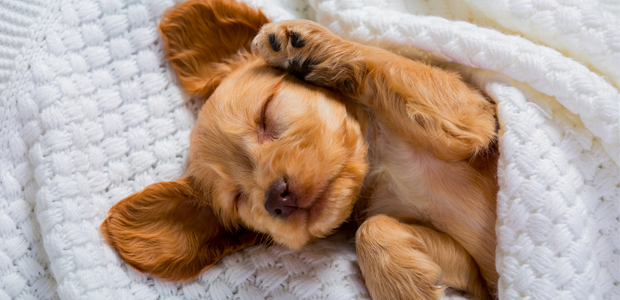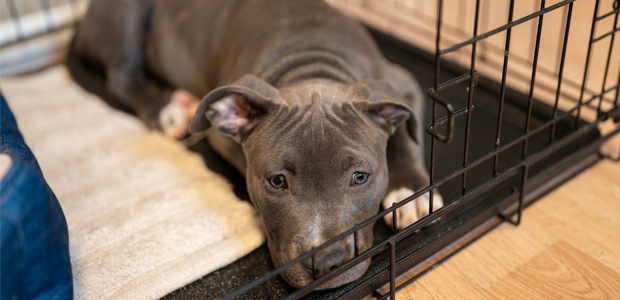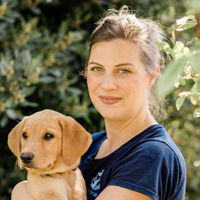How to get a puppy to sleep at night
If you’ve recently welcomed a new puppy into your home, or you’re thinking about adding a furry friend to your family, one of the first things to think about is their sleeping arrangements.
There are lots of different articles that offer wildly different approaches on the best way to get your puppy to sleep through the night, so it can become a confusing process.
We’ve asked leading animal behaviourist, Rosie Bescoby, to talk us through the best ways to get your puppy to sleep at night.
How much sleep do puppies need?
Puppies need anywhere between 12-16 hours of sleep a day, depending on how old they are. This may sound like a lot, but puppies take frequent naps throughout the day and don't save up their sleep for night time like we do.
Generally speaking, puppies can hold their bladder for 1 hour for every month old they are (so a three-month-old puppy can go three hours without needing to pee). Bear this in mind when you are toilet training.
Some puppies will be able to go the whole night without needing to go to the toilet from 8 weeks, but others might need to go out a few times a night for several weeks. When you take them out, keep things calm and try not to engage in play so that they can get used to their sleep schedule.
To give your puppy (and yourself) the best chance of a long, undisturbed sleep at night, make sure they are stimulated during the day. Puppies love playing, you can try lots of different games to keep them mentally stimulated such as hide and seek, fetch and tug of war. If they have been fully vaccinated, you can take them out for a walk.
However, be careful not to overload a young puppy physically or mentally. It’s best to keep play and exercise sessions short as a well-rested puppy will sleep better at night.

Read now: Best games for dogs to play
Should I ignore my puppy if they cry at night?
Your puppy will be experiencing lots of new things when they come home with you for the first time. For most, it will be the first time that they have spent time on their own, without the comfort of their mother and siblings.
Because they aren’t used to being alone, spending their first night by themselves can be upsetting. To make your pup feel more comfortable, you can put their bed or crate upstairs so that they still feel close to you. Once they have settled in, you can gradually increase the distance between your bed and wherever you plan to put your puppy's bed long-term.
Before you welcome a puppy into your home, it's a good idea to set up a dedicated area for your pup, where they can feel cosy and secure. Some people will want their dog to sleep downstairs or in a different room, whereas others will want their dog to sleep in the same room. It's entirely up to you where you'd like your dog to sleep
Having your puppy nearby to start with should stop them from becoming upset at night. If your puppy does start to whimper, you will be nearby to comfort them, as it’s important not to ignore your puppy if it shows distress.
Read now: Bringing home a new puppy: the ultimate guide
Crate training a puppy at night
Dog crates are a great way to give your dog a safe and secure place to sleep and retreat to. Pooches love having a dedicated den, and a crate is a great option for some.
When selecting a crate, the most important thing to consider is the size. Your pup will need enough space to move around; being able to comfortably stand, sit, stretch, and lay down when they are fully grown.
The crate shouldn’t be too large, as a cavernous space can make them feel unsafe. It needs to be a space where they can snuggle down and get cosy, whilst having enough space to remain comfortable.
Puppies don’t like to go to the bathroom where they sleep, so if you cover the bottom of the crate with a nice, soft blanket, they are less likely to soil inside their den. When it’s time to go to sleep, you can drape a blanket or a towel over the top of their crate to make them feel extra safe.

Read now: How to crate train a dog
To start off with, you might experience some difficulty getting your puppy to sleep in a crate. Puppies like to explore their surroundings and will likely sniff in and around their crate. Make it an inviting environment by filling it with blankets, toys and treats. Reward your dog for exploring their crate by giving them praise and treats.
By creating a positive association with the crate, you can get your pup used to being on their own and minimise the chance of them developing separation anxiety. If your dog falls asleep inside the crate, leave your dog and try to exit the room so that they get used to being on their own.
Crate training can take time, but it’s important not to shut the crate if your puppy isn’t happy being inside it. The door can be left open so that the pup can come and go as it pleases. Your dog might even prefer to sleep on a separate bed outside of the crate, which is fine.
Your puppy might not need a crate at all and if you decide against using one, make sure that your puppy has a nice warm bed that they can cosy into. You can set up a pen around the dog bed to create a secure environment that stops your pup from wandering off.
Need more info?
For more advice on helping your puppy settle in, have a chat with your local vet.
Find your nearest vet using our Find a Vet page, or speak to a vet online using Online Vets.

